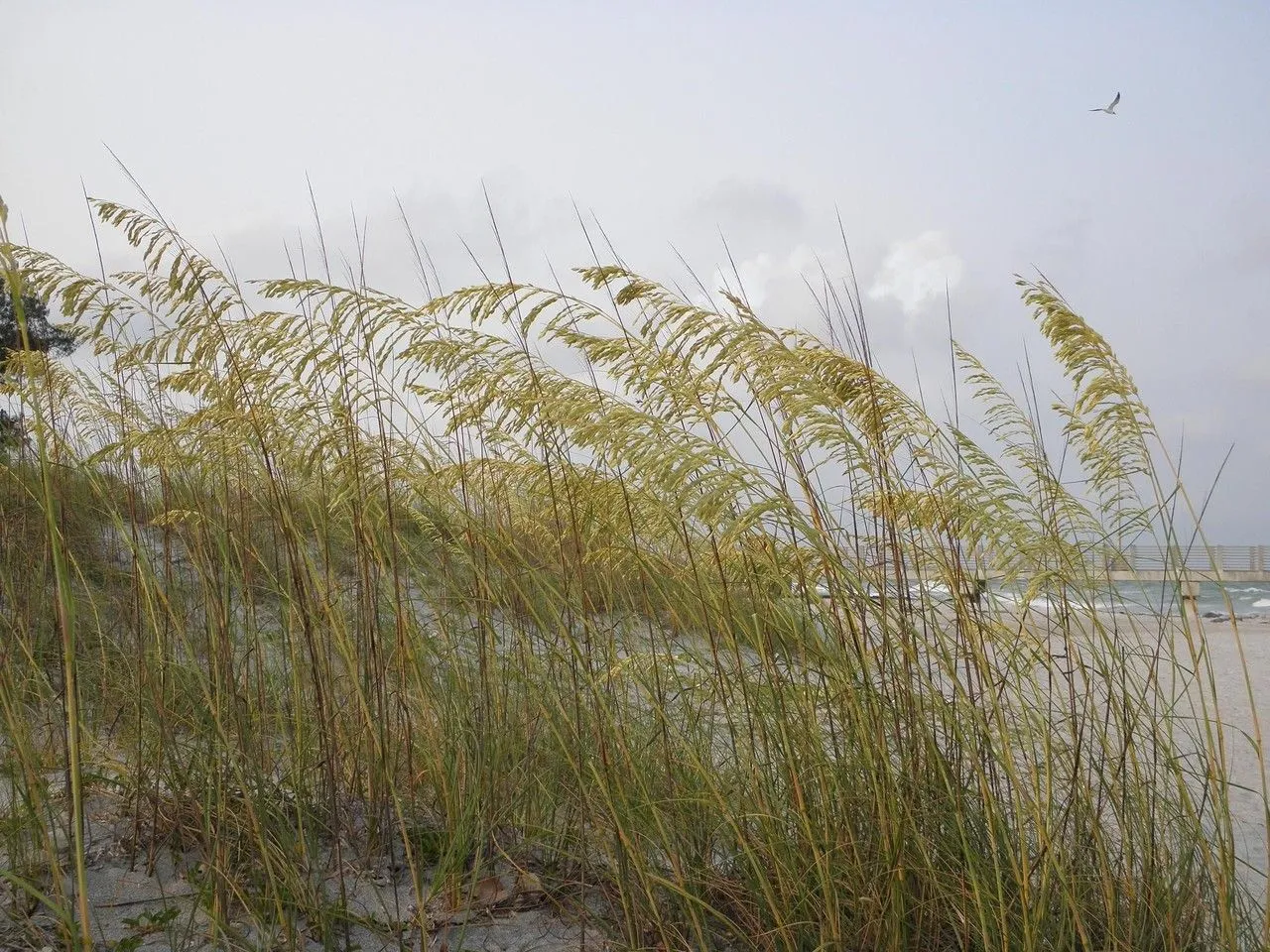
Author: L.
Bibliography: Sp. Pl.: 71 (1753)
Year: 1753
Status: accepted
Rank: species
Genus: Uniola
Vegetable: False
Observations: SE. U.S.A. to C. America, Caribbean
Seaside-oats, scientifically known as Uniola paniculata, is a notable member of the Poaceae family. Originally described by the renowned botanical author Linnaeus in the seminal work “Species Plantarum” in 1753, this plant has garnered significant attention due to its adaptability and ecological importance.
Uniola paniculata is predominantly found along the southeastern coast of the United States, extending its range into Central America and the Caribbean. This distribution reflects the plant’s remarkable ability to thrive in sandy, coastal environments where salt spray and shifting sands pose challenges for many types of vegetation.
Adaptations and Ecological Role:
One of the most striking features of seaside-oats is its robust root system, which plays a crucial role in stabilizing sandy soils. This ability to anchor substrates makes it an important ally in dune stabilization efforts, thereby preventing erosion and maintaining the integrity of coastal ecosystems. The plant’s tall, arching stems and delicate oat-like seed heads are not only attractive but are also designed to withstand the harsh conditions of its native habitats.
Growth and Appearance:
Seaside-oats typically grow to a height of 1 to 2 meters, showcasing an elegant silhouette. The inflorescences, or clusters of flowers, form large, graceful panicles that sway in the coastal winds, adding dynamic movement to the landscape. The seed heads mature into a light tan color, providing a picturesque scene against the backdrop of blue ocean waves or rolling dunes.
Cultural and Practical Uses:
Beyond its ecological importance, Uniola paniculata holds aesthetic value in landscaping, often utilized in coastal gardens and restoration projects. Its resilience to salt and ability to grow in nutrient-poor soils make it an ideal choice for these environments.
Conservation and Management:
Given its role in dune ecosystems, conservation efforts emphasize the protection of this species from human activities that may lead to habitat degradation. Beach nourishment projects, along with regulations that minimize foot traffic on dunes, are some of the measures employed to ensure the sustainability of seaside-oats populations.
In summary, Uniola paniculata, or seaside-oats, stands as a testament to nature’s ingenuity in adapting to and thriving within challenging environments. Its contributions to both ecological stability and coastal beauty underscore the importance of fostering this valuable plant within its native regions.
Eng: north american sea-oats, sea-oats, seaside-oats
Spa: araña, arroz de costa
Swe: plattax
En: Seaside-oats, North American sea-oats, Sea-oats, Horned lark, North American sea oats, Seaoats, Sea oats
Es: Arroz de costa, Araña
Sv: Plattax
Taken Jul 22, 2014 by EOL − Suzanne Cadwell (cc-by-nc)
Taken Jan 5, 2014 by EOL − Cullen Hanks (cc-by-nc)
Taken Nov 7, 2019 by Georgia O (cc-by-sa)
Taken Aug 13, 2021 by Andrea Bonnett (cc-by-sa)
Taken Nov 2, 2021 by Klara Law Maresova (cc-by-sa)
Taken Jun 15, 2011 by EOL − Sharpj99 (cc-by-nc-sa)
Taken Jul 7, 2013 by EOL − Mikael Behrens (cc-by-nc)
Taken Apr 20, 2012 by EOL − SharpJ99 (cc-by-nc-sa)
Taken Aug 23, 2014 by EOL − Matthew O’Donnell (cc-by-nc-sa)
Taken Jul 22, 2014 by EOL − Suzanne Cadwell (cc-by-nc)
Taken Jun 22, 2017 by Isaiah Amos (cc-by-sa)
Taken Jun 11, 2022 by RIVER STONE (cc-by-sa)
Taken Jul 9, 2019 by Lynette Lemay (cc-by-sa)
Taken Aug 16, 2019 by A.nasser Hakem (cc-by-sa)
Taken Jun 22, 2017 by Isaiah Amos (cc-by-sa)
Taken Jul 27, 2020 by Federico (cc-by-sa)
Taken Jul 2, 2015 by EOL − Kent McFarland (cc-by-nc)
Taken Oct 8, 2021 by wazoo laves (cc-by-sa)
Taken Dec 11, 2020 by Ivan Pequeno (cc-by-sa)
Taken Jun 22, 2017 by Isaiah Amos (cc-by-sa)
Taken Jun 20, 2013 by EOL − Arleigh Birchler (cc-by-nc)
Taken Nov 7, 2019 by Georgia O (cc-by-sa)
Growth form>: Rhizomatous
Growth habit>: Graminoid
Growth rate>: Slow
Ph maximum: 7.5
Ph minimum: 6.0
Family: Myrtaceae Author: (F.Muell.) K.D.Hill & L.A.S.Johnson Bibliography: Telopea 6: 402 (1995) Year: 1995 Status:…
Family: Rubiaceae Author: Pierre ex A.Froehner Bibliography: Notizbl. Bot. Gart. Berlin-Dahlem 1: 237 (1897) Year:…
Family: Sapindaceae Author: Koidz. Bibliography: J. Coll. Sci. Imp. Univ. Tokyo 32(1): 38 (1911) Year:…
Family: Asteraceae Author: A.Gray Bibliography: Pacif. Railr. Rep.: 107 (1857) Year: 1857 Status: accepted Rank:…
Family: Fabaceae Author: Medik. Bibliography: Vorles. Churpfälz. Phys.-Ökon. Ges. 2: 398 (1787) Year: 1787 Status:…
Family: Aspleniaceae Author: (Cav.) Alston Bibliography: Bull. Misc. Inform. Kew 1932: 309 (1932) Year: 1932…